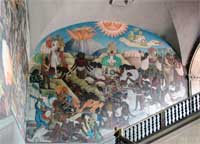
|
The right wall of the monumental stairwayMexico's legendary and precolonial past is represented here with the central focus on Quetzalcoatl, a god of the Toltecs, Mayans, and Aztecs. He wears a headdress of quetzal feathers and a conch on his chest, a symbol of the wind god; he carries a curved baton, the scepter of the seven stars or constellations. Behind him are the pyramids of the Sun and Moon in the city of Teotihuacan, the great political and religious center of pre-Hispanic Mexico. But the upside down sun indicates the decline of these pre-Hispanic cultures.
|
| |
|
Quetzalcoatl in human form as blond and whiteIt has often been said the Aztec Emperor Moctezuma II initially believed the landing of Hernán Cortés in 1519 to be Quetzalcoatl's return although modern scholarship has debunked this idea since the evidence for this theory is from documents of Spanish origin rather than from documents independent of post-Conquest Spanish influence. To his right are four aligned figures with outstretched arms which may represent the four elements in the prehispanic cosmos: earth, water, fire, and wind. Below various creative activities are represented: directly below him is a gold worker and next to him a ceramicist making pots. Across from them a sculptor engraves a large stele while a scribe paints a codex. At the far right of this detail a painter decorates a pot. This appears to be a golden age of harmony and creativity. |
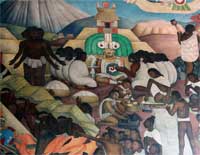
|
| |
|
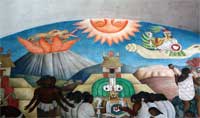
|
Quetzalcoatl in other formsOn the left, the plumed serpent rises from the erupting volcano's mouth--a divine form of Quetzalcoatl; on the right, Quetzalcoatl assumes the form of the morning star Tlahuizcalpantecuhtli, which appears near the sun at sunrise. Indian legend predicts his return to earth--an example of a common myth of eternal return. |
| |
|
The far leftThe left hand side depicts subject peoples bringing tribute--the huge bales, a grand victorious warrior colorfully dressed, and a prisoner of war wearing a garment with bone designs(?) waiting to be sacrificed(?). |

|
| |
|
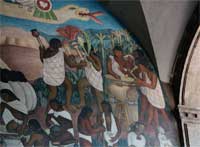
|
The far rightHere dancers and musicians engage in a ceremony before the corn harvest. Musicians play percussion instruments as well as horns (a conch shell). Other plants are also represented which some scholars suggest refer to drinks or hallucinogens they perhaps used in rituals. Below the dancers are farmers planting corn with the help of a kind of spade. |
| |
|
Left sideThe bottom left shows a battle between gloriously attired Aztec warriors and others. The weapons are apparently accurately depicted. |
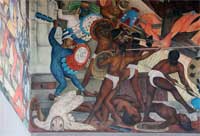
|
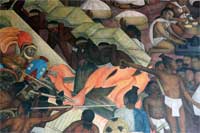
|
The shields' interiors of braided leather can be seen. Wooden swords (one is on the ground as well) have obsidian blades on the edges and two warriors hold obsidian axes. |


 Go to Rivera Murals Index.
Go to Rivera Murals Index. Go to the Mexico Index.
Go to the Mexico Index. Click here to return to index of art historical sites.
Click here to return to index of art historical sites.
 Click here to return to index of artists and architects.
Click here to return to index of artists and architects.
 Click here to return to chronological index.
Click here to return to chronological index.
 Click here to see the home page of Bluffton University.
Click here to see the home page of Bluffton University.

